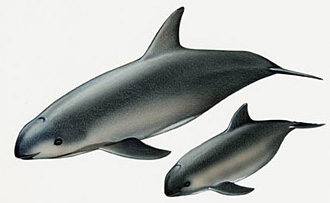
|  |  |  Editorials | Environmental | October 2008 Editorials | Environmental | October 2008  
Mexico, US, Canada to Protect Endangered Porpoise
 Mark Stevenson - Associated Press Mark Stevenson - Associated Press
go to original


| | The vaquita is the smallest of the porpoises. Mean length for females is 140 cm. The flippers are proportionately larger than in other phocoenids and the fin is taller and more falcate. The pigmentation is a dark grey cape, pale lateral field and white ventral field. There are large black eye rings and lip patches. The skull is smaller and the rostrum is shorter and broader than in other members of the genus. The vaquita is one of the most endangered cetacean species in the world (Rochas-Bracho and Jaramillo-Legoretta, 2002). | | |
Mexico City – Officials from Mexico, the United States and Canada are teaming up in a plan presented Tuesday to protect the vaquita marina, a highly endangered species of porpoise in the upper Gulf of California.

Canadian and U.S. experts will join their Mexican counterparts in studying the rare animal and working to convince fishermen in Gulf communities to abandon fine-mesh gill nets and other techniques that threaten the species.

As part of the effort, a U.S. research ship has begun setting out a network of acoustic monitoring devices in the Gulf of California in a bid to determine the number and location of surviving vaquitas. Researchers hope to finish collecting initial data by December.

The North American Commission for Environmental Cooperation, which is helping coordinate the effort, said only about 150 of the elusive vaquitas remain in the wild, and as many as 40 are killed each year by fishing nets.

"Unless concrete conservation actions are taken, the effective size of the population ... may fall to just 50 adults in the next two years," the commission said in a statement.

The plan calls on the United States and Canada to encourage investment in fishing communities to create other jobs for residents. |

 |
|  |



